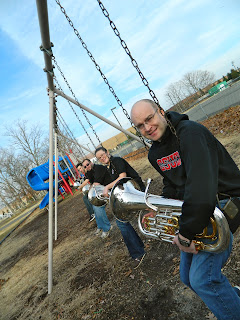I have many discussions with my fellow band members at Atlantic Brass Band about the subject of musical gestures in brass band contest music, so I thought that there may be some people out there online who might also find my opinion interesting. Whether you agree with my thoughts or not, hopefully reading this will get you to think about your own philosophy on the subject.
In my mind, there are a lot fewer musical gestures out there in brass band music than we might think, or want to admit. To me, modern brass band contest literature seems composed so that the very best of the best (sometimes, I think theoretical) band can play it perfectly. The rest of us fall somewhere in varying degrees short of that often theoretical perfection.
In these most incredibly difficult test pieces that are coming out for championship-level brass bands today, there are plenty of passages that seem simply "unplayable" after a glance or even a month's worth of work. I think that many people label some of these passages as "gestures," or sections of the piece to get the gist of and move on. However, when musicians label a difficult passage as a gesture, I see an important mental change happen in the preparation of that section of the piece. That musician's work on that passage will stop when they get the general idea of the passage, instead of working to get as close as possible to the originally intended notes because it's been labeled a gesture.
I see parallels between test pieces and college admission standardized tests. Only the very few smartest students and best studiers will get a perfect score on their ACT's or SAT's. Many students, however, will study on their own or get tutors before they take the tests because even though there will be seemingly impossible questions on those tests, the most diligent students will still want to get the highest score possible. Simply saying that parts of the test are impossible really isn't the best option for a good score.
In contesting, I try to look at these nearly impossible passages that occasionally appear as more of a "weeding out" passage. The composer knows that these sections are nearly impossible and put them there to test the ability of the performer. If everyone could play every note in the whole piece perfectly, it would be impossible for the judges to score. In reality, the best bands will fall somewhere at the top of the continuum while the struggling bands will fall lower. The important thing, to me, is to never give up on getting closer to that gold standard of perfection. I understand that we'll never play every note how we wanted or even sometimes play all of them at all, but we should keep trying. I also do understand that there are some genuine gestures in contest music, even if I don't think they're as common as we think. In the end, the word doesn't really even matter. If a musician can call a difficult passage of music a gesture and continue to work on it to get it as close as the composer intended, great. But, if it's a mental game of looking at what many would call a musical gesture and refusing to see it as such in order to become a better player, then repeat after me: "There is no gesture."






